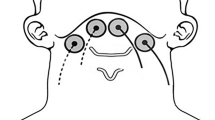Abstract
Objective
The advantages of nasal high-flow oxygen therapy (NHF) include not only allowing talking, but also eating and drinking, during the therapy. However, the effect of NHF on the swallowing reflex remains unclear. In the present study, we aimed to assess the effects of NHF on the swallowing reflex.
Methods
Nine healthy adult Japanese male volunteers with no history of dysphagia or diseases that may cause dysphagia, such as stroke or Parkinson’s disease, were evaluated. Participants received one of four levels of NHF intervention (0 (control), 15, 30 and 45 L/min of oxygen) with the NHF system through the nasal cannula. Swallowing was induced by the administration of a bolus injection of 5 mL of distilled water over 3 s through a polyethylene catheter at each level of oxygen flow. The primary end-point was the latency period of the swallowing reflex after bolus injection, which was defined as the time from the start of the bolus injection to the onset of the electromyogram (EMG) burst of the first swallow.
Results
Mean latency times of the swallowing reflex with 15 (9.8 ± 2.9 s), 30 (9.0 ± 2.7 s) and 45 (8.5 ± 3.0 s) L/min of NHF were significantly shorter than those under control conditions (11.9 ± 3.7 s; P < 0.05).
Conclusions
Our study demonstrates that NHF may enhance swallowing function with increasing levels of NHF by reducing the latency of the reflex.
Clinical relevance
NHF may allow continuation of oral intake without aspiration during oxygen therapy.



Similar content being viewed by others
References
Gotera C, Díaz Lobato S, Pinto T, Winck JC (2013) Clinical evidence on high flow oxygen therapy and active humidification in adults. Rev Port Pneumol 19:217–227
Powell NB, Riley RW, Guilleminault C, Murcia GN (1988) Obstructive sleep apnea, continuous positive airway pressure, and surgery. Otolaryngol Head Neck Surg 99:362–369
Rennotte MT, Baele P, Aubert G, Rodenstein DO (1995) Nasal continuous positive airway pressure in the perioperative management of patients with obstructive sleep apnea submitted to surgery. Chest 107:367–374
Manley BJ, Owen LS, Doyle LW, Andersen CC, Cartwright DW, Pritchard MA, Donath SM, Davis PG (2013) High-flow nasal cannulae in very preterm infants after extubation. N Engl J Med 369:1425–1433
Nishino T (2013) The swallowing reflex and its significance as an airway defensive reflex. Front Physiol 3:489
Mündel T, Feng S, Tatkov S, Schneider H (2013) Mechanisms of nasal high flow on ventilation during wakefulness and sleep. J Appl Physiol (1985) 114:1058–1065
Nishino T, Sugimori K, Kohchi A, Hiraga K (1989) Nasal constant positive airway pressure inhibits the swallowing reflex. Am Rev Respir Dis 140:1290–1293
Parke R, McGuinness S, Eccleston M (2009) Nasal high-flow therapy delivers low level positive airway pressure. Br J Anaesth 103:886–890
Groves N, Tobin A (2007) High flow nasal oxygen generates positive airway pressure in adult volunteers. Aust Crit Care 20:126–131
Samson N, Roy B, Ouimet A, Moreau-Bussière F, Dorion D, Mayer S, Praud JP (2008) Origins of the inhibiting effects of nasal CPAP on nonnutritive swallowing in newborn lambs. J Appl Physiol 105:1083–1090
Nishino T, Hasegawa R, Ide T, Isono S (1998) Hypercapnia enhances the development of coughing during continuous infusion of water into the pharynx. Am J Respir Crit Care Med 157:815–821
Nishino T (1993) Swallowing as a protective reflex for the upper respiratory tract. Anesthesiology 79:588–601
Corley A, Caruana LR, Barnett AG, Tronstad O, Fraser JF (2011) Oxygen delivery through high-flow nasal cannulae increase end-expiratory lung volume and reduce respiratory rate in post-cardiac surgical patients. Br J Anaesth 107:998–1004
Frizzola M, Miller TL, Rodriguez ME, Zhu Y, Rojas J, Hesek A, Stump A, Shaffer TH, Dysart K (2011) High-flow nasal cannula: impact on oxygenation and ventilation in an acute lung injury model. Pediatr Pulmonol 46:67–74
Bräunlich J, Beyer D, Mai D, Hammerschmidt S, Seyfarth HJ, Wirtz H (2013) Effects of nasal high flow on ventilation in volunteers, COPD and idiopathic pulmonary fibrosis patients. Respiration 85:319–325
Acknowledgments
We would like to thank Dr. Stanislav Tatkov (Fisher & Paykel Healthcare) for reviewing our paper and giving us suggestions that significantly improved our paper. Dr. Sanuki would like to extend his indebtedness to his deceased brother, Mr. Yoshiro Sanuki, for his support and encouragement throughout the study.
The preliminary data of this study were presented as a poster presentation at Euroanaesthesia 2015 (The European Anaesthesiology Congress), June 1, 2015, Berlin.
Author information
Authors and Affiliations
Corresponding author
Ethics declarations
Ethical approval
Ethical approval for this study (Ref No. 1395) was provided by the ethics committee of the Nagasaki University Graduate School of Biomedical Science, Nagasaki, Japan (Chairperson Prof. Takehiko Koji) on Dec 27, 2013.
Funding
This work was partially supported by a 2014 research grant from the General Foundation Hojin-kai, Nagasaki University Hospital.
Conflicts of interest
The authors declare that they have no conflicts of interest.
Informed consent
Informed consent was obtained from all individual participants included in the study.
Rights and permissions
About this article
Cite this article
Sanuki, T., Mishima, G., Kiriishi, K. et al. Effect of nasal high-flow oxygen therapy on the swallowing reflex: an in vivo volunteer study. Clin Oral Invest 21, 915–920 (2017). https://doi.org/10.1007/s00784-016-1822-3
Received:
Accepted:
Published:
Issue Date:
DOI: https://doi.org/10.1007/s00784-016-1822-3




